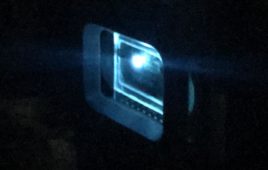
Courtesy image
These are the journeys of the “StarChip Wafersize.”
UC Santa Barbara students sent up, via balloon, a prototype miniature spacecraft that might eventually become the “wafercraft” that researchers posit could be propelled by lasers to achieve space travel at relativistic speeds to reach nearby star systems and exoplanets.
So begins a journey, funded by NASA and several private foundations, that may one day lead to interstellar travel.
“It’s part of a process of building for the future, and along the way you test each part of the system to refine it,” said UC Santa Barbara physics professor and experimental cosmologist Philip Lubin. “It’s part of a long-term program to develop miniature spacecraft for interplanetary and eventually for interstellar flight.”
The prototype wafer scale spacecraft (WSS) is small enough to fit in the palm of one hand. It was launched into the stratosphere above Pennsylvania, to an altitude of 105,000 feet (32 km) three times that of commercial airplanes—to gauge its functionality and performance.
The launch was conducted in collaboration with the United States Naval Academy in Annapolis on April 12, 2019—58 years to the day that Russian cosmonaut and pilot Yuri Gagarin became the first human to complete orbital space flight.
“It was designed to have many of the functions of much larger spacecraft, such as imaging, data transmission, including laser communications, attitude determination and magnetic field sensing,” said Nic Rupert, a development engineer in Lubin’s lab. “Due to the rapid advancements in microelectronics we can shrink a spacecraft into a much smaller format than has been done before for specialized applications such as ours.”
The spacecraft prototype worked flawlessly and collected more than 4000 images of the Earth in what Rupert said was “an excellent first flight and it will evolve dramatically from here.”
The project’s goal, as the device’s name suggests, is to build an ultra-lightweight (gram scale) silicon wafer with embedded electronics, capable of being shot into space while relaying data back to Earth. For the distance the researchers want to achieve—roughly 25 trillion miles, or 40 trillion kilometers, cruising at a significant fraction of the speed of light—the technology required is daunting.
“Ordinary chemical propulsion, such as that which took us to the moon nearly 50 years ago to the day, would take nearly one hundred thousand years to get to the nearest star system, Alpha Centauri,” Lubin said. “And even advanced propulsion such as ion engines would take many thousands of years. There is only one known technology that is able to reach the nearby stars within a human lifetime and that is using light itself as the propulsion system.”
Known as directed energy propulsion, the technology requires building an extremely large array of lasers to act as the propulsion. This system does not travel with the spacecraft; it remains on Earth.
“If you have a large enough laser array, you can actually push the wafers with a laser sail to get to our goal of 20 percent of the speed of light,” Rupert said. “Then you’d be at Alpha Centauri in something like 20 years.”
Part of a NASA-funded endeavor called Starlight, the effort is supported also by the Breakthrough Foundation, where it is known as Starshot. UC Santa Barbara initiated the project in 2009 with modest funding from NASA’s Spacegrant program, receiving additional funds in 2015 via NASA Advanced Concepts.
The UC Santa Barbara team then approached billionaire tech investor Yuri Milner’s Breakthrough Foundation in 2016 to share the implications of the technology. In April of that same year, the foundation announced it would undertake a $100 million effort to back this program.
The purpose is to answer one of humanity’s biggest existential questions: Are we alone in the universe? And one way to find out, according to the researchers, is to visit nearby exoplanets by sending a multitude of these tiny spacecraft to nearby star systems. These chips would contain nanoscale cameras, navigation equipment, communications technology and other systems to search nearby exoplanets far beyond our solar system for evidence of life.
Still another facet of the UC Santa Barbara project involves sending life from Earth into space. The researchers want to test the idea of transporting life over vast distances using radiation-hardened, cryo sleep-capable, space-hardy tiny animals—specifically, tardigrades and the nematode c. elegans.
But first, the technology has to exist. Thanks to advances in photonics and silicon electronics, seeds of the final products have been planted, say the scientists. Repeated attempts to send the evolving hardware into ever-farther reaches of our atmosphere, and gradually into outer space and beyond, are what they hope will seal the deal.
“The point of building these things is to know what we want to include in the next version, in the next chip,” said David McCarthy, a graduate student in the Department of Electrical and Computer Engineering. “You start with off-the-shelf components because you can iterate quickly and inexpensively.” At this stage, he said, the idea is to see how well the hardware works under increasingly harsh conditions, including freezing temperatures, extended exposure to radiation such as cosmic rays and collisions with particles between Earth and the stars (the interstellar medium), and the hard vacuum of space.
The momentum is building. An interdisciplinary undergraduate group, consisting of students from physics, engineering, chemistry and biology, are conducting balloon flights to gather data that may eventually inform the development of future versions of the wafercraft. As the technology becomes increasingly sophisticated, the researchers said, they can engage the semiconductor industry to turn out these tiny spacechips in bulk at low cost.
Meanwhile, innovations in silicon optics and integrated wafer-scale photonics are making it possible to reduce the costs of the laser array used for launching these spacecraft. Faculty and researchers in UC Santa Barbara’s electrical and computer engineering department are playing a critical role.
“It’s not that unrealistic to think that we can make one-gram pieces of silicon that are going to have everything we want on them,” McCarthy said.
Ultimately shooting for interstellar space, which is still quite a way off, the group is aiming for a suborbital first flight next year. The development of such technology paves the way toward a variety of space missions that would have been considered too costly or impossible with conventional chemical rocket-powered technology.
Potential benefits of the core technology? Much shorter trip times to Mars than is currently possible; planetary defense against asteroids and comets; mitigating space debris, boosting Earth-orbiting satellites, or remotely powering distant solar system outposts, among many others, noted Lubin.
“It enables a whole class of technological abilities,” he said, of directed energy propulsion. “Some of the more interesting, short-term ones would involve interplanetary missions.”
The UCSB group has published over technical 50 papers on the transformational technology they are developing and the radical implications it has for human exploration.


